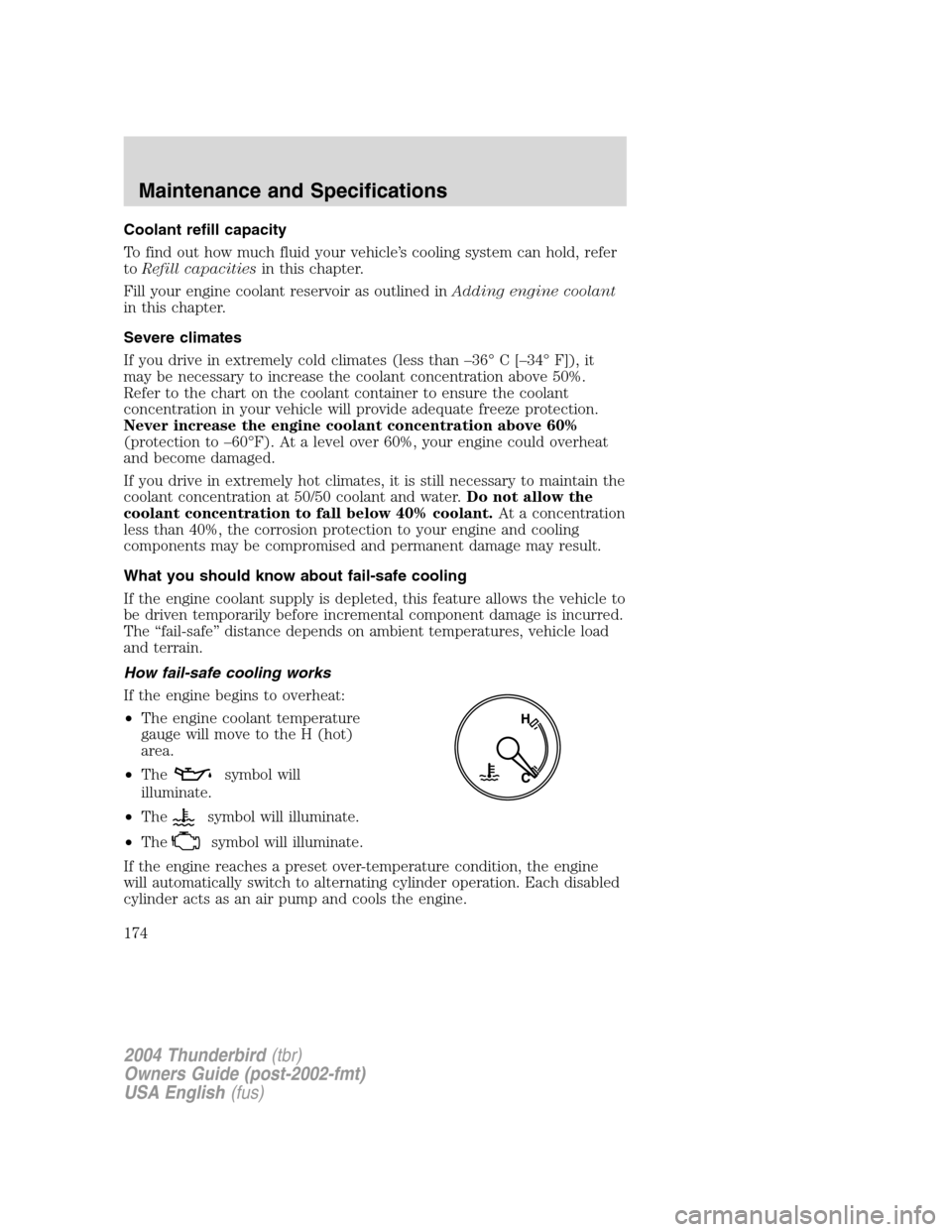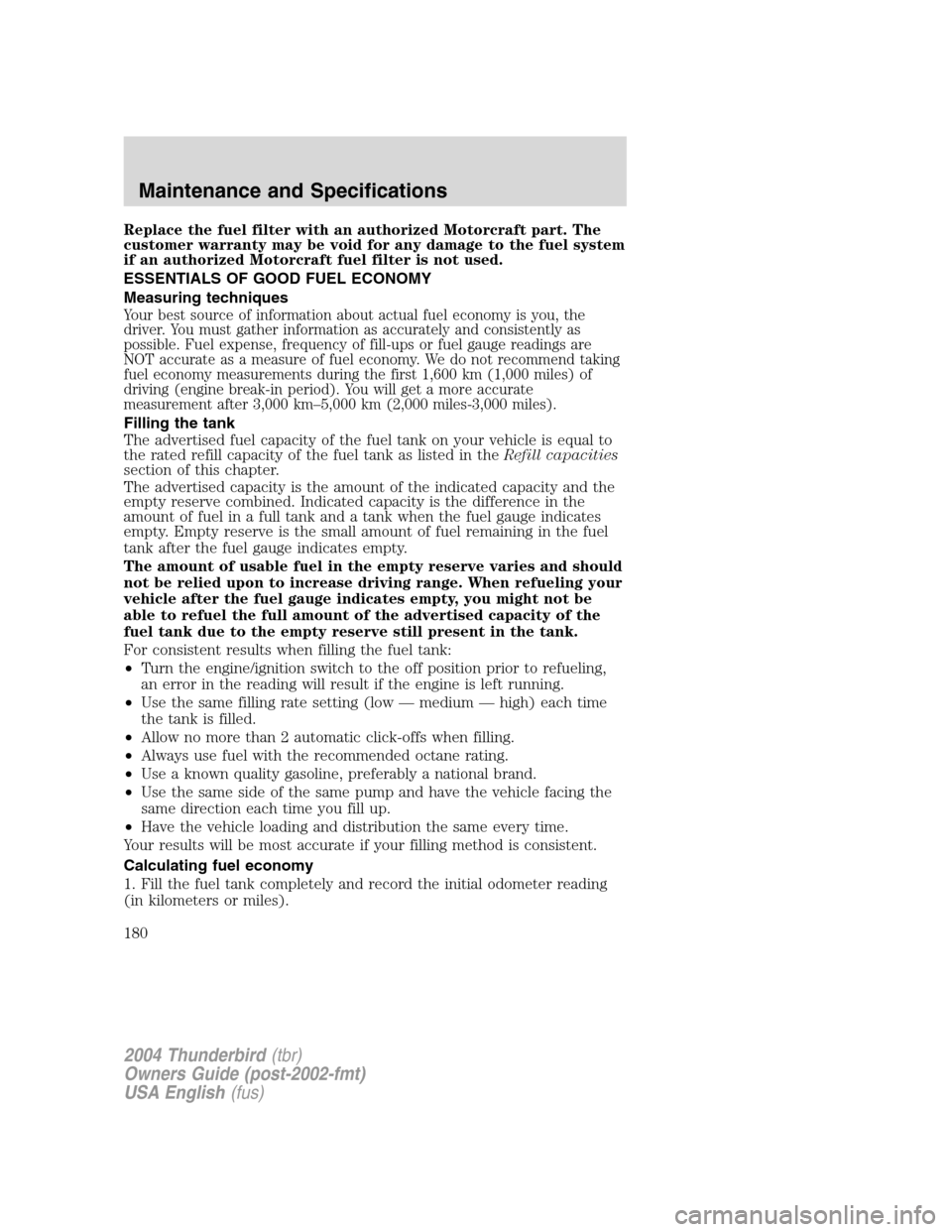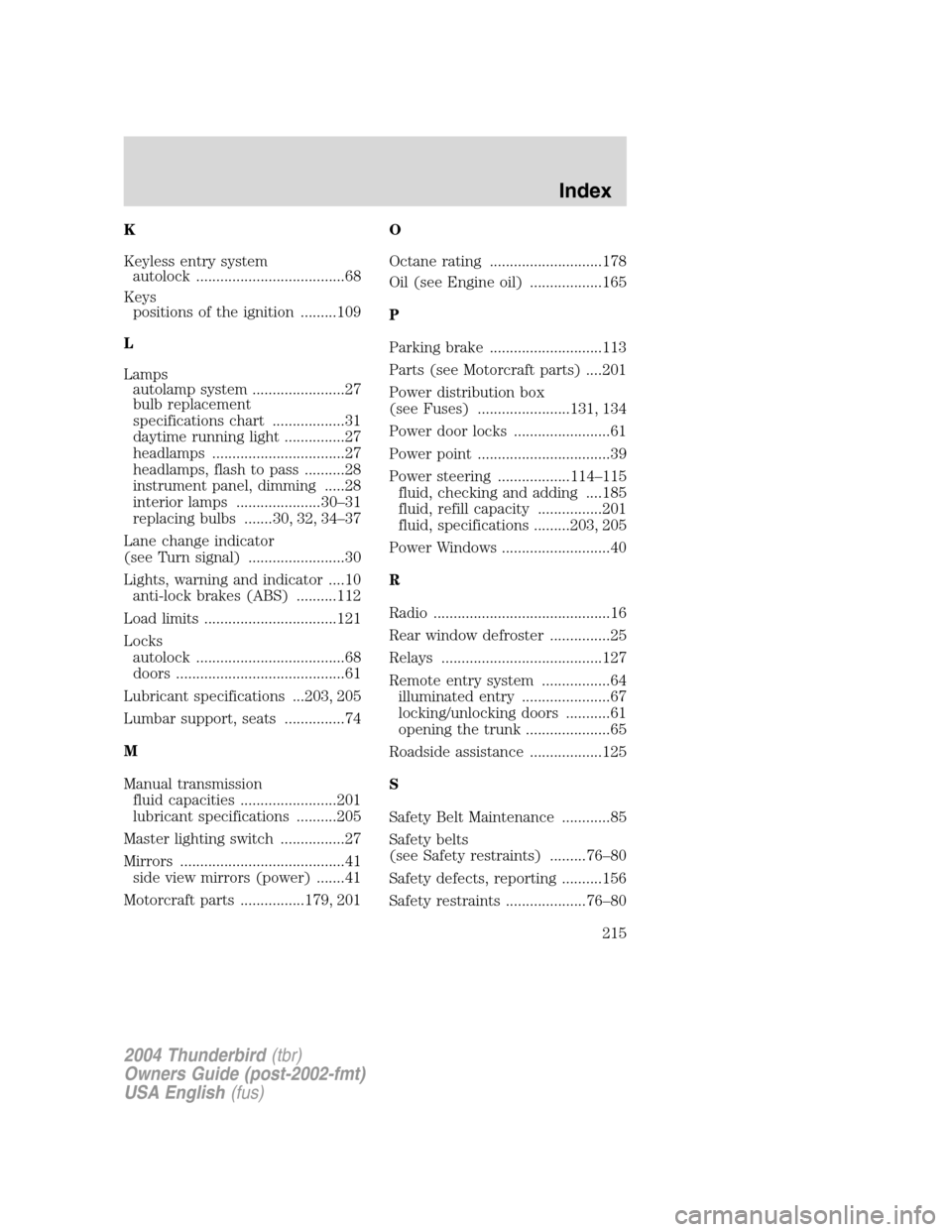load capacity FORD THUNDERBIRD 2004 11.G Owners Manual
[x] Cancel search | Manufacturer: FORD, Model Year: 2004, Model line: THUNDERBIRD, Model: FORD THUNDERBIRD 2004 11.GPages: 216, PDF Size: 5.69 MB
Page 174 of 216

Coolant refill capacity
To find out how much fluid your vehicle’s cooling system can hold, refer
to Refill capacities in this chapter.
Fill your engine coolant reservoir as outlined in Adding engine coolant
in this chapter.
Severe climates
If you drive in extremely cold climates (less than –36 °C[ –34 °F]), it
may be necessary to increase the coolant concentration above 50%.
Refer to the chart on the coolant container to ensure the coolant
concentration in your vehicle will provide adequate freeze protection.
Never increase the engine coolant concentration above 60%
(protection to –60 °F). At a level over 60%, your engine could overheat
and become damaged.
If you drive in extremely hot climates, it is still necessary to maintain the
coolant concentration at 50/50 coolant and water. Do not allow the
coolant concentration to fall below 40% coolant. At a concentration
less than 40%, the corrosion protection to your engine and cooling
components may be compromised and permanent damage may result.
What you should know about fail-safe cooling
If the engine coolant supply is depleted, this feature allows the vehicle to
be driven temporarily before incremental component damage is incurred.
The “fail-safe ”distance depends on ambient temperatures, vehicle load
and terrain.
How fail-safe cooling works
If the engine begins to overheat:
• The engine coolant temperature
gauge will move to the H (hot)
area.
• The
symbol will
illuminate.
• The
symbol will illuminate.
• The
symbol will illuminate.
If the engine reaches a preset over-temperature condition, the engine
will automatically switch to alternating cylinder operation. Each disabled
cylinder acts as an air pump and cools the engine.
2004 Thunderbird (tbr)
Owners Guide (post-2002-fmt)
USA English (fus)
Maintenance and Specifications
174
Page 180 of 216

Replace the fuel filter with an authorized Motorcraft part. The
customer warranty may be void for any damage to the fuel system
if an authorized Motorcraft fuel filter is not used.
ESSENTIALS OF GOOD FUEL ECONOMY
Measuring techniques
Your best source of information about actual fuel economy is you, the
driver. You must gather information as accurately and consistently as
possible. Fuel expense, frequency of fill-ups or fuel gauge readings are
NOT accurate as a measure of fuel economy. We do not recommend taking
fuel economy measurements during the first 1,600 km (1,000 miles) of
driving (engine break-in period). You will get a more accurate
measurement after 3,000 km–5,000 km (2,000 miles-3,000 miles).
Filling the tank
The advertised fuel capacity of the fuel tank on your vehicle is equal to
the rated refill capacity of the fuel tank as listed in the Refill capacities
section of this chapter.
The advertised capacity is the amount of the indicated capacity and the
empty reserve combined. Indicated capacity is the difference in the
amount of fuel in a full tank and a tank when the fuel gauge indicates
empty. Empty reserve is the small amount of fuel remaining in the fuel
tank after the fuel gauge indicates empty.
The amount of usable fuel in the empty reserve varies and should
not be relied upon to increase driving range. When refueling your
vehicle after the fuel gauge indicates empty, you might not be
able to refuel the full amount of the advertised capacity of the
fuel tank due to the empty reserve still present in the tank.
For consistent results when filling the fuel tank:
• Turn the engine/ignition switch to the off position prior to refueling,
an error in the reading will result if the engine is left running.
• Use the same filling rate setting (low —medium —high) each time
the tank is filled.
• Allow no more than 2 automatic click-offs when filling.
• Always use fuel with the recommended octane rating.
• Use a known quality gasoline, preferably a national brand.
• Use the same side of the same pump and have the vehicle facing the
same direction each time you fill up.
• Have the vehicle loading and distribution the same every time.
Your results will be most accurate if your filling method is consistent.
Calculating fuel economy
1. Fill the fuel tank completely and record the initial odometer reading
(in kilometers or miles).
2004 Thunderbird (tbr)
Owners Guide (post-2002-fmt)
USA English (fus)
Maintenance and Specifications
180
Page 215 of 216

K
Keyless entry systemautolock .....................................68
Keys positions of the ignition .........109
L
Lamps autolamp system .......................27
bulb replacement
specifications chart ..................31
daytime running light ...............27
headlamps .................................27
headlamps, flash to pass ..........28
instrument panel, dimming .....28
interior lamps .....................30 –31
replacing bulbs .......30, 32, 34 –37
Lane change indicator
(see Turn signal) ........................30
Lights, warning and indicator ....10 anti-lock brakes (ABS) ..........112
Load limits .................................121
Locks autolock .....................................68
doors ..........................................61
Lubricant specifications ...203, 205
Lumbar support, seats ...............74
M
Manual transmission fluid capacities ........................201
lubricant specifications ..........205
Master lighting switch ................27
Mirrors .........................................41 side view mirrors (power) .......41
Motorcraft parts ................179, 201 O
Octane rating ............................178
Oil (see Engine oil) ..................165
P
Parking brake ............................113
Parts (see Motorcraft parts) ....201
Power distribution box
(see Fuses) .......................131, 134
Power door locks ........................61
Power point .................................39
Power steering ..................114
–115
fluid, checking and adding ....185
fluid, refill capacity ................201
fluid, specifications .........203, 205
Power Windows ...........................40
R
Radio ............................................16
Rear window defroster ...............25
Relays ........................................127
Remote entry system .................64 illuminated entry ......................67
locking/unlocking doors ...........61
opening the trunk .....................65
Roadside assistance ..................125
S
Safety Belt Maintenance ............85
Safety belts
(see Safety restraints) .........76 –80
Safety defects, reporting ..........156
Safety restraints ....................76 –80
2004 Thunderbird (tbr)
Owners Guide (post-2002-fmt)
USA English (fus)
Index
215